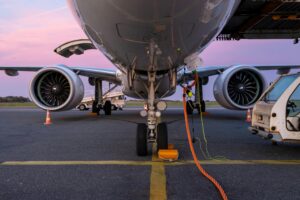In the heart of Nairobi, where the skies pulse with ambition and the hum of jet engines signals opportunity, Kenya Airways (KQ) has scripted a remarkable comeback. The airline’s 2024 financial year, marked by a KES5.4 billion (USD41.8 million) profit after years of losses, is not just a milestone—it’s a beacon for African carriers navigating turbulent skies. Under the banner of Project Kifaru, Kenya Airways has embraced fiscal discipline, operational agility, and strategic foresight, offering lessons that resonate across the continent’s aviation landscape. But what can other African airlines glean from KQ’s playbook? And why is its focus on mid-life fleet upgrades and fuel-efficiency retrofits, rather than costly fleet renewals, a game-changer? Let’s explore.
A Turnaround Rooted in Strategy
Kenya Airways’ journey from a KES22.6 billion (USD175 million) loss in 2023 to a profit in 2024 is no fluke. Acting CFO Mary Mwenga attributes this to Project Kifaru, a multi-year restructuring plan that prioritized cost discipline, smarter route planning, and digital transformation. The airline’s 6% revenue growth to KES188 billion (USD1.45 billion) was fueled by a 4% rise in passenger traffic and a 25% surge in cargo tonnage, particularly in high-margin perishables. Strategic alliances, notably with KLM Royal Dutch Airlines, and AI-powered systems for route planning and maintenance have slashed costs. Fuel hedging and proactive forex management saved millions, while renegotiated debt terms bolstered the balance sheet.
For African airlines, often battered by volatile currencies, high fuel costs, and fragmented markets, KQ’s disciplined approach is a masterclass. Many carriers, from South African Airways to Ethiopian Airlines’ smaller peers, grapple with similar challenges: thin margins, aging fleets, and overreliance on passenger revenue. KQ’s pivot to cargo, leveraging Africa’s growing agricultural exports, shows how diversification can stabilize cash flow. Its use of AI for route optimization and outsourcing for maintenance and catering underscores the power of technology and partnerships to drive efficiency. The lesson? Success lies in sweating the small stuff—every shilling saved, every process streamlined, every alliance maximized.
Fleet Upgrades vs. Fleet Renewal: A Financial Reckoning
At the core of KQ’s strategy is a bold choice: invest in mid-life fleet upgrades and fuel-efficiency retrofits rather than splurging on new aircraft. With four of nine leased B737-800s nearing lease expiry in 2026 and two B787-8s in 2027, KQ is doubling down on extending the life of its existing fleet. But why choose upgrades over renewal, and what financial benefits does this hold for cash-strapped African carriers?
The Case for Mid-Life Upgrades
Mid-life upgrades involve retrofitting existing aircraft with modern avionics, fuel-efficient engines, and aerodynamic enhancements like winglets. These upgrades can reduce fuel consumption by 5-15%, a significant saving given that fuel accounts for 30-40% of an airline’s operating costs. For KQ, retrofitting its B737-800s and B787-8s extends their operational life by 5-10 years, delaying the need for capital-intensive fleet replacements. According to industry estimates, retrofitting a narrowbody like the B737 can cost USD2-5 million per aircraft, compared to USD80-100 million for a new one. For widebodies like the B787, upgrades might run USD5-10 million, versus USD250-300 million for a new aircraft.
Beyond fuel savings, upgrades improve reliability and passenger experience. Modernized cabins with updated seats and in-flight entertainment systems can boost customer satisfaction and revenue per available seat kilometer (RASK). KQ’s focus on flexible lease terms tailored to seasonal demand further optimizes costs, ensuring aircraft aren’t sitting idle during low seasons. For African airlines, where capital markets are tight and debt burdens heavy, this approach preserves liquidity while maintaining competitiveness.
The High Cost of Fleet Renewal
Fleet renewal, while tempting, is a financial behemoth. New aircraft promise cutting-edge efficiency—modern jets like the Boeing 737 MAX or Airbus A320neo can cut fuel burn by 15-20% compared to older models. But the upfront cost is staggering. A single narrowbody can set an airline back USD80-120 million, and widebodies like the A350 or B787 can exceed USD250 million. Financing these purchases often means long-term debt or leasing agreements that lock carriers into fixed costs, a risky proposition in Africa’s volatile markets. Moreover, new aircraft require retraining pilots and maintenance crews, adding to expenses.
For many African airlines, fleet renewal is a distant dream. South African Airways, for instance, has struggled to fund new aircraft amid government bailouts, while smaller carriers like Air Tanzania face delays in scaling up due to capital constraints. KQ’s pragmatic choice to retrofit rather than replace sidesteps these hurdles, delivering immediate cost savings without the long-term financial strain.
Lessons for the Continent
Kenya Airways’ strategy offers a roadmap for African airlines, but it’s not one-size-fits-all. Here are the key takeaways:
1. Embrace Fiscal Prudence: KQ’s debt reduction and fuel hedging show that financial discipline is non-negotiable. African carriers must prioritize positive cash flow, renegotiate debt, and hedge against currency and fuel volatility to build resilience.
2. Diversify Revenue Streams: The 25% jump in cargo tonnage highlights the untapped potential of freight, especially for perishables like flowers and produce. Airlines like RwandAir or Uganda Airlines could tap into regional agricultural hubs to offset passenger market fluctuations.
3. Leverage Technology and Partnerships: AI-driven route planning and strategic alliances, like KQ’s with KLM, amplify efficiency. Smaller carriers could partner with global players or regional giants like Ethiopian Airlines to share maintenance facilities or codeshare routes.
4. Prioritize Upgrades Over Renewal: For airlines with aging fleets—like Nigeria’s Arik Air or Zambia Airways—mid-life upgrades offer a cost-effective way to boost efficiency and passenger appeal without breaking the bank.
5. Align Capacity with Demand: KQ’s flexible leasing strategy ensures aircraft match seasonal traffic patterns. This agility is critical in Africa, where demand can swing wildly due to economic, political, or climatic factors.
The Road Ahead
Kenya Airways’ turnaround is a testament to what’s possible when strategy meets execution. Yet, challenges remain. Supply chain bottlenecks and maintenance slot shortages, which have grounded four of KQ’s Boeing aircraft, underscore the fragility of Africa’s aviation ecosystem. Regional carriers must advocate for better access to spare parts and maintenance infrastructure, perhaps through pan-African collaborations.
Moreover, KQ’s cargo push and digital transformation require sustained investment. African airlines must balance short-term gains with long-term innovation, ensuring they don’t just survive but thrive in a competitive global market. Ethiopian Airlines, the continent’s gold standard, has shown how scale and ambition can coexist—KQ’s Project Kifaru suggests smaller players can punch above their weight with the right playbook.
A Call to Action
As the sun sets over Jomo Kenyatta International Airport, Kenya Airways’ story is a clarion call for African aviation. The continent’s skies are vast, but its airlines have long been tethered by financial woes and operational inefficiencies. KQ’s focus on mid-life upgrades, cargo growth, and fiscal discipline proves that transformation is possible without betting the farm on new fleets. For carriers across Africa, the lesson is clear: innovate, adapt, and execute. The skies are waiting.
Disclaimer: The insights shared in this article are for informational purposes only and do not constitute strategic advice. Aviation markets and circumstances vary, and decisions should be based on your organization’s specific context. For tailored consultancy and guidance, please contact info@avaerocapital.com.




